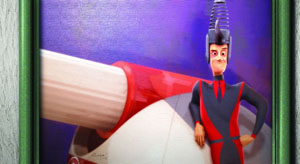- Disneyland
Disneyland Resort, Anaheim California
Disneyland Guide
Pictures
Columns & Reports
News/Events
- Walt Disney World
Walt Disney World, Orlando Florida
WDW Guide
Pictures
News/Events
- Features/News
- Columns
- Int. Parks
International Disney Parks
- About
|
||
|
|
| Related
Media (and Links) |
|
ANIMATING THE ROBINSONS: In 2005, Walt Disney Feature Animation added its first fully computer-animated feature film to its long list of technological achievements with the release of “Chicken Little.” For the first time, that film put computer tools in the hands of some of the industry’s top artistic talents. They, in turn, adapted such classic Disney animation principles as “squash and stretch” – a technique that lends a rounded quality and vibrant, fluid motion to characters – to the CG world with endearingly zany results. After fully committing himself 100% to all the foibles and futuristic dreams of the characters in MEET THE ROBINSONS, Steve Anderson echoes that sentiment. “I never wavered from that one idea that these characters have a story to tell,” he says. “There were a lot of obstacles, technicalities and struggles along the way, but, whatever was happening, we all just kept muttering that one fantastic phrase to ourselves – keep moving forward – and it kept us going all the way.” |
| Back to Main Theater Page |
|
|
|
home
| disneyland
resort | walt
disney world | site map
| site index No part of this website may be reproduced in whole or in part without permission. disneygeek.com is not affiliated with The Walt Disney Company in any way. The official Disney site is available at www.disney.com All Disney parks, attractions, characters, titles, etc. are registered trademarks of The Walt Disney Company. This site provides independent news articles, commentary, editorials, reviews, and guides primarily about the theme parks of the Walt Disney Company.
|

 But the characters of MEET THE ROBINSONS would stretch Disney’s animators even further and in entirely new directions by presenting them with a species they’d never animated in a computer before: human beings. The filmmakers knew it wouldn’t be a simple transition. After all, digitally animating humans in life-like ways has proven fraught with complications in its very brief history. For all the amazing progress computers have made over the last few years, they still haven’t quite matched up to the incredible variability of human characteristics. That means compromises have to be made – but for Steve Anderson, the key was making sure, no matter the technical difficulties, that the Robinsons would come off as far more than “cartoon cutouts” and become people the audience actually care about.
But the characters of MEET THE ROBINSONS would stretch Disney’s animators even further and in entirely new directions by presenting them with a species they’d never animated in a computer before: human beings. The filmmakers knew it wouldn’t be a simple transition. After all, digitally animating humans in life-like ways has proven fraught with complications in its very brief history. For all the amazing progress computers have made over the last few years, they still haven’t quite matched up to the incredible variability of human characteristics. That means compromises have to be made – but for Steve Anderson, the key was making sure, no matter the technical difficulties, that the Robinsons would come off as far more than “cartoon cutouts” and become people the audience actually care about.